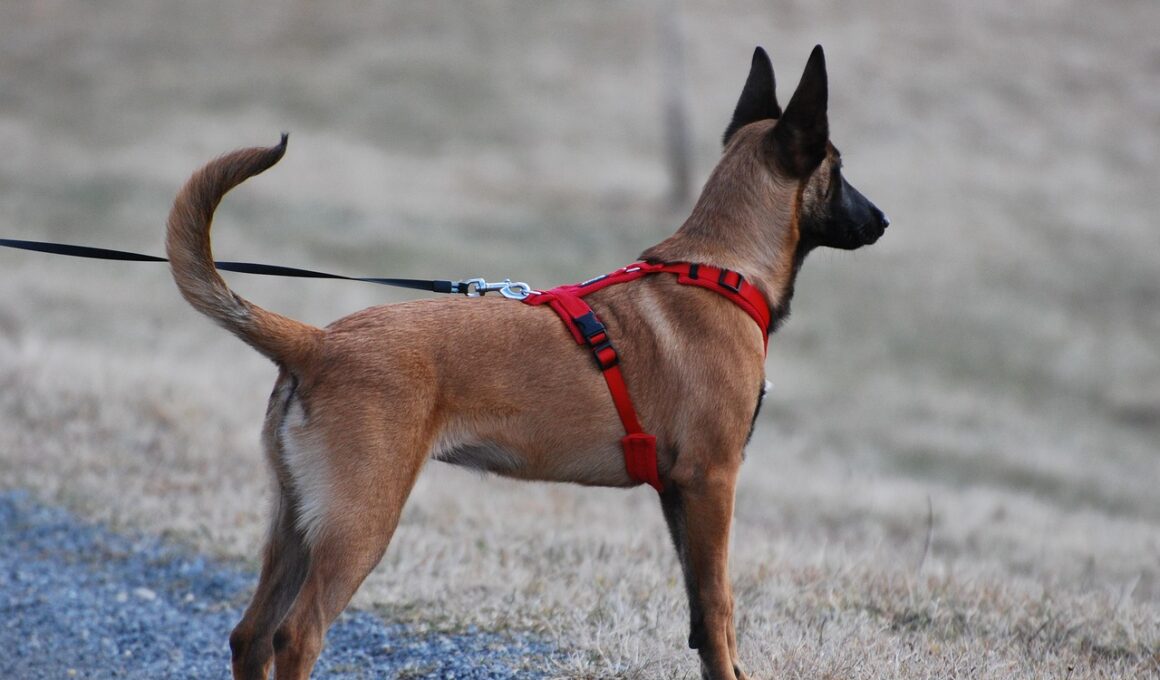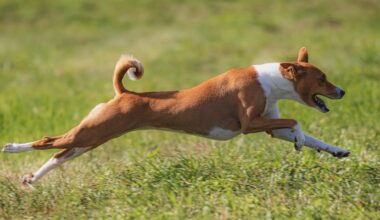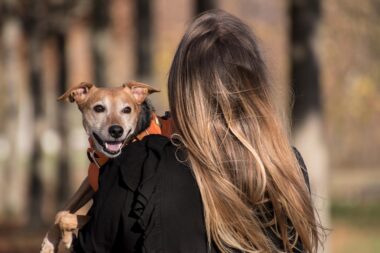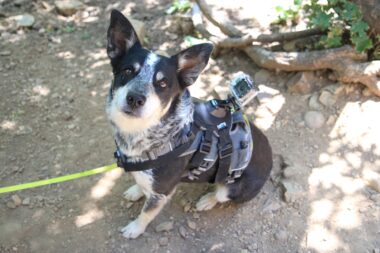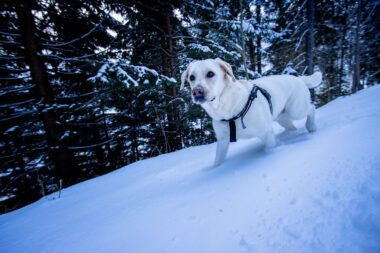Harnesses for Dogs That Pull: Managing Strong Pullers
Strong pullers present unique challenges for dog owners. Harnesses are designed to provide more control while ensuring your dog’s comfort. A harness distributes pressure across a dog’s body, reducing strain on the delicate neck area. When selecting a harness, consider the fit, material, and construction quality. The right harness should allow for natural movement without causing discomfort or chafing. Investing in a well-constructed harness can make walks enjoyable for both owner and dog. Some harnesses come with reflective materials, ensuring visibility during night walks. Training your dog to walk calmly on a leash is essential. Using a harness combined with positive reinforcement methods can alter pulling behavior over time. Gradually, your dog will learn to associate walking on a loose leash with rewards, eventually leading to a more manageable walking experience. The right choice will empower you to walk confidently. Explore options from brands known for their quality and reliability. Consider adjustable models to ensure a perfect fit. Check for reviews and recommendations to find effective solutions. A suitable harness can transform your walks from chaotic to enjoyable.
Choosing a harness requires careful evaluation of your dog’s unique needs. Each breed exhibits different behavior, strength, and pulling style. For small dogs, lightweight harnesses are ideal. In contrast, larger breeds may need padded options to absorb shock. Ensure the harness has a front clip option for better control if your dog tends to lunge. Harnesses with multiple attachment points provide versatility, adapting to various walking styles. Dogs who engage in active play may benefit from a durable and sturdy design, ensuring safety during all activities. Comfort is paramount; thus, look for breathable materials, especially in warmer weather, to prevent overheating. Selecting an ergonomic harness can enhance your dog’s experience. When introducing the harness, allow your dog to explore it gradually. Use treats and encouragement to associate it with positive experiences. This patience during the introduction phase fosters acceptance. Don’t forget to test the fit frequently as your dog grows. Check for snugness without being overly tight to avoid restriction of movement. The right harness will improve not just your walks but also your dog’s overall well-being. Evaluate your options, and invest in quality for lasting results.
Training Methods for Strong Pullers
Effective training is vital for managing strong pullers. Incorporating training techniques can gradually reduce pulling behaviors. Begin with basic commands like sit and stay. These foundational skills enhance communication between you and your dog. Using a clicker or verbal rewards during training sessions reinforces desired behaviors. When your dog starts pulling, stop walking; wait until tension is released before continuing. This strategy helps your dog learn that pulling leads to a halt in the walk. Additionally, practice leash walking in a distraction-free environment initially. Gradually increase distractions as your dog becomes more compliant. Consistency is key; ensure everyone walking your dog uses the same commands and reinforcement methods. Gradual exposure helps reinforce the learning process. Positive experiences build confidence and encourage compliance. Invest in a high-quality harness suited for training sessions. Consider using a no-pull harness to discourage pulling. Engage in short, frequent training sessions, making it fun to improve progress. You might include play sessions as a reward for calm behavior during walks. Together, these training taps can create a more enjoyable partnership, enhancing your relationship with your four-legged friend.
Regular walks are essential for a dog’s physical and mental well-being. Strong pullers need structured activity to burn off excess energy. Determine the ideal distance and frequency that suits your dog’s breed and age. Gradual adjustments to your walking routine can make a big difference. Introducing variety in your walking routes can pique your dog’s interest at every turn. New scents and sights stimulate them mentally, making walks more enjoyable. Include short, active play sessions to enhance the overall experience. Using interactive toys can also keep your dog engaged while walking. Implementing obstacle courses in your yard can improve their focus as well. Remember to adjust your expectations based on your dog’s progress. Celebrate every victory, big or small, on your journey together. Engage with local dog groups to discover new walking partners to further enhance your walks. Socialization with other dogs encourages structured behavior during outings. Tracking your dog’s improvement can motivate and encourage both of you. Ultimately, regular walks build stronger bonds, leading to a happier, healthier canine companion. Finding a balance between activity and rest is essential for a successful and enjoyable routine.
Safety Tips for Harness Usage
Safety should always be your priority when using a harness. Regularly inspect the harness for any signs of wear and tear. Check the buckles, straps, and clips. If you notice fraying or damage, it’s time to replace it. Ensuring your dog’s comfort should also be paramount. A comfortable fit encourages calmness, easing stress during walks. Always ensure your dog is secured before opening any doors or gates. This prevents any escape attempts when your dog bolts. If your dog becomes overly excited, consider using a secure leash that can contain their excitement. When not in use, store the harness properly to prolong its life. Clean the harness regularly according to the manufacturer’s instructions, preventing the build-up of debris. Make it a habit to assess your dog’s behavior and comfort levels while wearing the harness. Avoid overly tight harnesses that can cause discomfort. Invest in reflective harness options for better visibility at night. Pair the harness with a sturdy leash offering a comfortable grip for you. The combination of these safety practices will increase confidence during walks and adventures. A safe, enjoyable experience is essential for both of you.
Exploring various harness options on the market is crucial to find the best solution. Each harness offers unique features suited for diverse needs. Brands like Kurgo, PetSafe, or Ruffwear present various choices designed for performance, durability, and comfort. Researching product reviews and feedback can inform your decisions. Take time to visit local pet stores to try different harnesses on your dog for proper fitting. Allowing your dog to test the harness increases the chances of finding the right model. Pay attention to features such as padding, adjustability, and material quality. A well-constructed harness should withstand the test of time and activity. Consider aspects like ease of cleaning and weather-resistant materials as well. Some harnesses come equipped with additional functionalities, such as storage pockets for treats. User-friendly designs promote easy on-and-off access, saving valuable time and effort. Evaluate your dog’s behavior and size to make informed choices about which design fits best. Transitioning to the right harness can significantly enhance both your walks and your dog’s attitude during outings. Remember that the right choice isn’t solely about aesthetics but about function, comfort, and safety.
Conclusion: Finding the Right Fit
In conclusion, managing strong pullers requires careful selection of equipment along with training. A well-fitted harness is a crucial component in ensuring enjoyable walks. Your investment will pay off in both quality of life and overall wellness for your dog. Regular training sessions and positive reinforcement are equally important to discourage pulling habits. Establishing a structured approach helps build confidence and encourages good behavior. Assessing your dog’s needs based on breed, size, and energy helps streamline your harness selection process. Prioritize comfort through adjustable features and breathable materials. Engaging with fellow dog owners can provide valuable insights and recommendations that may become transformative. Safety must also be a priority in your harness choice, capable of withstanding wear over time while ensuring security during outings. As you explore various harnesses and training methods, be patient with the learning curve. Celebrate each step in your dog’s journey towards becoming a well-behaved companion. Remember, the right fit goes beyond the material; it forms the basis of a harmonious relationship between you and your dog. The joy of daily walks awaits you both with a little commitment and the right tools.
This final paragraph sums it all up and offers a thoughtful conclusion to the article, emphasizing the importance of careful selection combined with consistent training, ensuring your dog’s and your happiness during walks.
